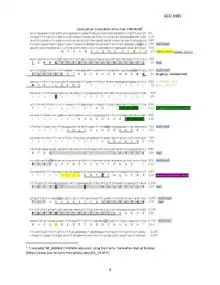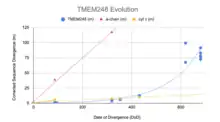TMEM248
Transmembrane protein 248, also known as C7orf42, is a gene that in humans encodes the TMEM248 protein. This gene contains multiple transmembrane domains and is composed of seven exons.TMEM248 is predicted to be a component of the plasma membrane and be involved in vesicular trafficking.[1][2] It has low tissue specificity, meaning it is ubiquitously expressed in tissues throughout the human body. Orthology analyses determined that TMEM248 is highly conserved, having homology with vertebrates and invertebrates. TMEM248 may play a role in cancer development. It was shown to be more highly expressed in cases of colon, breast, lung, ovarian, brain, and renal cancers.[3]
| TMEM248 | |||||||||||||||||||||||||||||||||||||||||||||||||||
|---|---|---|---|---|---|---|---|---|---|---|---|---|---|---|---|---|---|---|---|---|---|---|---|---|---|---|---|---|---|---|---|---|---|---|---|---|---|---|---|---|---|---|---|---|---|---|---|---|---|---|---|
| Identifiers | |||||||||||||||||||||||||||||||||||||||||||||||||||
| Aliases | TMEM248, C7orf42, transmembrane protein 248 | ||||||||||||||||||||||||||||||||||||||||||||||||||
| External IDs | MGI: 1918917 HomoloGene: 9951 GeneCards: TMEM248 | ||||||||||||||||||||||||||||||||||||||||||||||||||
| |||||||||||||||||||||||||||||||||||||||||||||||||||
| |||||||||||||||||||||||||||||||||||||||||||||||||||
| |||||||||||||||||||||||||||||||||||||||||||||||||||
| |||||||||||||||||||||||||||||||||||||||||||||||||||
| Wikidata | |||||||||||||||||||||||||||||||||||||||||||||||||||
| |||||||||||||||||||||||||||||||||||||||||||||||||||
Gene
TMEM248 is located at chromosome 7 at location 7q11.21 with 37,327 base pairs, spanning from position 66,921,225 to 66,958,551.[8][9] It has 7 exons and is located on the sense strand.[9][10]
Transcript
TMEM248 contains 7 exons, seen in Figure 1. A single gene can have multiple isoforms produced by alternative splicing. TMEM248 has four isoforms summarized in Table 1.
| Isoform Number | Accession Number | Transcript Length | Protein Length | Molecular Weight |
|---|---|---|---|---|
| 1 | Q9NWD8-1,[11] NM_017994.5[12] | 4,229 | 314 | 35 kDa |
| X1 | XP_024302587.1[13] | 4,246 | 322 | 36 kDa |
| X2 | XM_024446821.2[14] | 4,008 | 314 | 35 kDa |
| X3 | XM_024446820.2[15] | 4,010 | 314 | 35 kDa |
Messenger RNA

An annotated conceptual translation of TMEM248 is seen in Figure 1. TMEM248 mRNA is most highly expressed in the thyroid, endometrium, prostate, testis, and ovaries, though it is ubiquitously expressed at varying levels in most tissue types.[9]
Protein
TMEM248 is a multi-pass component of the membrane and functions in protein binding and vesicular transport.[1][2] TMEM248 has both low tissue and single cell type specificity, but single cell expression cluster is in macrophages.[16] The polypeptide chain of TMEM248 is 314 amino acids long and the molecular weight is approximately 35 kDa. TMEM248 is threonine-rich, meaning that it has a higher-than-average amount of threonine residues.[17] Additionally, it is a more acidic than basic molecule.[17] The basal isoelectric point of TMEM248 is 5.91 pH.
Subcellular localization
Immunofluorescence staining shows TMEM248 localization to vesicles.The subcellular location of TMEM248 is predicted to be the endoplasmic reticulum membrane, in vesicles, and in the plasma membrane.[18][19]
Post-translational modifications
Predicted post-translational modifications for TMEM248 protein include glycosylation, ubiquitylation, and phosphorylation. Ubiquitylation at K228, K240, and K245, glycosylation at N80, and phosphorylation at Y13 and S300 were experimentally determined.[10][20]

Homology and evolution
Homologs of the TMEM248 gene are found in vertebrates and invertebrates. The most distant orthologs of TMEM248 are in echinoderms, mollusks, and arthropods, which diverged approximately 680 million years ago.[22] Orthologs of TMEM248 are not found in annelids, nematodes, cnidarians, sponges, fungi, plants, or bacteria.
| Genus and Species | Common name | Order | DoD* (MYA) | Accession | Length | % Similarity | % Identity |
| Homo sapiens | Human | Primate | 0 | NP_060464.1 | 314 | 100 | 100 |
| Mus musculus | House mouse | Rodentia | 87 | NP_082130.1 | 314 | 98.7 | 94.6 |
| Phyllostomus discolor | Pale spear-nosed bat | Chiroptera | 94 | XP_028369740 | 314 | 99.4 | 96.5 |
| Gallus gallus | Chicken | Galiformes | 319 | XP_024997905.1 | 324 | 95.2 | 90.4 |
| Hirundo rustica | Barn swallow | Passeriformes | 319 | XP_039938558 | 314 | 95.9 | 91.1 |
| Mauremys mutica | Yellow pond turtle | Testudines | 319 | XP_044849258 | 314 | 96.2 | 92.0 |
| Bufo bufo | Common toad | Anura | 353 | XP_040279401 | 315 | 94.3 | 85.1 |
| Xenopus tropicalis | Western clawed frog | Anura | 353 | NP_001007494.1 | 315 | 93.7 | 84.1 |
| Geotrypetes seraphini | Gaboon caecilian | Gymnophiona | 353 | XP_033777821 | 313 | 93.9 | 88.5 |
| Ictalurus punctatus | Channel catfish | Siluriformes | 431 | XP_017315532 | 315 | 92.1 | 81.0 |
| Danio rerio | Zebrafish (teleost) | Cypriniformes | 431 | NP_001013548 | 314 | 88.0 | 76.5 |
| Triplophysa tibetana | Stone loach (ray finned fish) | Cypriniformes | 431 | KAA0716418 | 332 | 88.0 | 78.0 |
| Chiloscyllium plagiosum | White spotted bamboo shark | Orectolobiformes (carpet) | 464 | XP_043574478 | 321 | 92.5 | 83.8 |
| Carcharodon carcharias | Great white shark | Lamniformes (mackerel) | 464 | XP_041053841 | 321 | 92.2 | 83.8 |
| Strongylocentrotus purpuratus | Pacific purple sea urchin | Echinoida | 619 | XP_003725226.2 | 307 | 50.9 | 34.0 |
| Apostichopus japonicus | Sea cucumber | Stichopodidae | 619 | PIK58986.1 | 244 | 37.0 | 19.1 |
| Aplysia californica | California sea hare | Anaspidea | 680 | XP_005091558.1 | 372 | 43.6 | 27.9 |
| Blattella germanica | German cockroach | Blattodea | 680 | PSN49789.1 | 275 | 48.4 | 30.8 |
| Cryptotermes secundus | Drywood termite | Isoptera | 680 | XP_023712247.1 | 281 | 45.9 | 29.8 |
| Parasteatoda tepidariorum | Common house spider | Araneae | 680 | XP_042905814.1 | 305 | 43.7 | 23.6 |
| Mizuhopecten yessoensis | Yesso scallop | Pectinida | 680 | OWF52152 | 367 | 46.2 | 30.1 |
| Plakobranchus ocellatus | Ring sap sucking slug | Saccoglossa | 680 | GFO37695.1 | 406 | 40.1 | 26.5 |
*DoD = date of divergence; MYA = million years ago.

TMEM248 has two paralogs in humans: TMEM219 and insulin-like growth factor binding protein 3 (IGFBP3) receptor isoform 2 precursor. The TMEM219 protein has 34.9% similarity and 21.1% identity to TMEM248. The IGFBP3 receptor isoform 2 precursor protein has 36.4% similarity and 21.9% identity to TMEM248.
TMEM219 is a death receptor that induces apoptosis (a type of programmed cell death) via a caspase-8 dependent mechanism, and the ligand for this receptor is IGFBP3. The TMEM219/IGFBP3 signaling pathway is experimentally shown to regulate pancreatic beta cell function.[24]
| Genus and Species | Common name | Order | DoD (MYA) | Accession | Length | % Similarity | % Identity |
| Homo sapiens TMEM219 | Human | Primate | 0 | KAI2578024.1 | 213 | 34.9 | 21.1 |
| Homo sapiens IGFBP3 | Human | Primate | 0 | P_001356618.1 | 240 | 36.4 | 21.9 |
| Mus musculus TMEM219 | House mouse | Rodentia | 87 | AAH46763.1 | 240 | 34.9 | 21.1 |
| Mus musculus IGFBP3 | House mouse | Rodentia | 87 | NP_081103.1 | 240 | 36.8 | 21.4 |
| Python bivittatus IGFBP3 | Burmese python | Squamata | 319 | XP_007424393 | 242 | 40.5 | 21.8 |
| Geotrypetes seraphini IGFBP3 | Gaboon caecilian | Gymnophiona | 353 | XP_033802587 | 373 | 32.6 | 19.7 |
| Denticeps clupeoides IGFBP3 | Denticle herring | Clupeiformes | 431 | XP_028848129 | 300 | 40.7 | 19.8 |
Clinical significance
TMEM248 has proposed connections to various forms of cancer. Mutations in the gene have been recorded in tumor samples from stomach, colorectal, lung, bladder, ovarian, endometrial, and breast cancer.[16] Of the tumor samples observed, stomach tumors were most likely to contain mutations of TMEM248. There is relatively higher expression of TMEM248 in colon, breast, lung, ovarian, brain, and renal cancer.[25] Multiple myeloma (cancer of unrestricted B cell proliferation in bone marrow) progression and drug sensitivity could regulate TMEM248 expression.[26] These experimentally determined conclusions implicate TMEM248 playing a role in cell proliferation, and make expression of TMEM248 a potential candidate for more intensive studies in the development of cancer in these organs. However, the TMEM248 gene product is not prognostic for cancer with the current available research.
References
- "TMEM248 transmembrane protein 248 [Homo sapiens (human)] - Gene - NCBI". www.ncbi.nlm.nih.gov. Retrieved 2022-09-20.
- "TMEM248 Polyclonal Antibody (PA5-53435)". www.thermofisher.com. Retrieved 2022-12-15.
- Sehovic, Emir; Hadrovic, Adem; Dogan, Senol (2019-11-10). "Detection and analysis of stable and flexible genes towards a genome signature framework in cancer". Bioinformation. 15 (10): 772–779. doi:10.6026/97320630015772. ISSN 0973-2063. PMC 6900328. PMID 31831960.
- GRCh38: Ensembl release 89: ENSG00000106609 - Ensembl, May 2017
- GRCm38: Ensembl release 89: ENSMUSG00000053094 - Ensembl, May 2017
- "Human PubMed Reference:". National Center for Biotechnology Information, U.S. National Library of Medicine.
- "Mouse PubMed Reference:". National Center for Biotechnology Information, U.S. National Library of Medicine.
- "TMEM248". UCSC Genome Browser. University of California, Santa Cruz. Retrieved 3 August 2022.
- "TMEM248 transmembrane protein 248 [ Homo sapiens (human) ]". National Library of Medicine. NCBI. Retrieved 30 July 2022.
- "TMEM248 Gene - Transmembrane Protein 248". GeneCards. Weizmann Institute of Science. Retrieved 3 August 2022.
- "UniProt". www.uniprot.org. Retrieved 2022-12-15.
- "Homo sapiens transmembrane protein 248 (TMEM248), mRNA". 2021-06-26.
{{cite journal}}: Cite journal requires|journal=(help) - "transmembrane protein 248 isoform X1 [Homo sapiens] - Protein - NCBI". www.ncbi.nlm.nih.gov. Retrieved 2022-12-15.
- "PREDICTED: Homo sapiens transmembrane protein 248 (TMEM248), transcript variant X2, mRNA". 2022-04-05.
{{cite journal}}: Cite journal requires|journal=(help) - "PREDICTED: Homo sapiens transmembrane protein 248 (TMEM248), transcript variant X3, mRNA". 2022-04-05.
{{cite journal}}: Cite journal requires|journal=(help) - "Tissue expression of TMEM248 - Summary - The Human Protein Atlas". www.proteinatlas.org. Retrieved 2022-12-15.
- "EBI Tools: Job not available". www.ebi.ac.uk. Retrieved 2022-12-15.
- "PSORT WWW Server". psort.hgc.jp. Retrieved 2022-12-15.
- "{{ngMeta['og:title']}}". bio.tools. Retrieved 2022-12-15.
- "TMEM248 (human)". www.phosphosite.org. Retrieved 2022-12-15.
- "IBS - Online". ibs.biocuckoo.org. Retrieved 2022-12-15.
- "TimeTree of Life". TimeTree 5, The TimeScale of Life. Institute for Genomics and Evolutionary Medicine Center of Biodiversity Temple University. Retrieved 3 August 2022.
- "BLAST: Basic Local Alignment Search Tool". blast.ncbi.nlm.nih.gov. Retrieved 2022-12-15.
- D’Addio, Francesca; Maestroni, Anna; Assi, Emma; Ben Nasr, Moufida; Amabile, Giovanni; Usuelli, Vera; Loretelli, Cristian; Bertuzzi, Federico; Antonioli, Barbara; Cardarelli, Francesco; El Essawy, Basset; Solini, Anna; Gerling, Ivan C.; Bianchi, Cristina; Becchi, Gabriella (2022-02-03). "The IGFBP3/TMEM219 pathway regulates beta cell homeostasis". Nature Communications. 13 (1): 684. Bibcode:2022NatCo..13..684D. doi:10.1038/s41467-022-28360-2. ISSN 2041-1723. PMC 8813914. PMID 35115561.
- Sehovic, Emir; Hadrovic, Adem; Dogan, Senol (2019-11-10). "Detection and analysis of stable and flexible genes towards a genome signature framework in cancer". Bioinformation. 15 (10): 772–779. doi:10.6026/97320630015772. ISSN 0973-2063. PMC 6900328. PMID 31831960.
- Ida, Vänttinen (2020). "Drug Response and Disease Progression Associated MicroRNAs in Multiple Myeloma".
{{cite journal}}: Cite journal requires|journal=(help)



